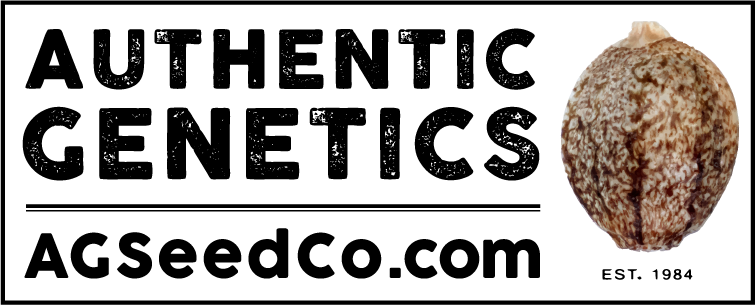
Photo: "Purest Indica" plant from the original 1980's seeds.
Legacy and Heirloom Genetics
Authentic Genetics is dedicated to preserving the legacy and heirloom genetics that have circulated within the community for the last 50 years and beyond.
We have the ultimate distinction of being the only cannabis seed company in the world to have gotten all of these genetics directly from the legendary breeders Skunkman Sam, Mel Frank and Seattle Greg, who first supplied them to the community in the 70s and 80s.
Please see our collection of Legacy and Heirloom varieties.
Original Skunk #1: our Skunk #1 seeds have only been reproduced two times since the 80s and they are the original combination that favors the Afghan and still makes thiols, which cause the acrid/skunky smell. In 1988 Skunkman Sam gave some Skunk seeds to Mel Frank who put them in his refrigerator for the next eight years until 1996 when he reproduce them in his Los Angeles garden. Put those reproductions back into the refrigerator and they stayed there for 23 years until 2019 when he gave some to Todd who grew them and realized that they still smelled acrid. Todd reproduced them in 2020 and those are the seats available on the website today.
Science has now revealed that thiols are responsible for the skunky smell in cannabis and these seeds still make those nasty smelling compounds.
Please see our article on how you can grow skunky smelling cannabis:
How to Grow Skunky Smelling Cannabis
Original Haze: This was truly the unicorn in the forest for us to capture. Haze is legendary and has been since its inception in 1969. Saved by Skunkman Sam and the early 70s, it has been maintained by Skunkman as inbred line for decades.
Todd acquired original Haze in 2012, when he was receiving the Cannabis Culture Award in Amsterdam and Barcelona. Skunkman Sam came to the event and Todd used the opportunity to ask him if he could get the original Haze seeds. Fortunately, Skunkman Sam obliged and in 2018 Sam also gave permission to Todd to reproduce the variety for others.
The Northern Lights collection is exceptional on many levels. We acquired these genetics directly from Seattle Greg, who told us that they were saved in the freezer since the 80s. These seeds have only been reproduced once since the early 80s. They are the old authentic genetics.
"Purest Indica" a.k.a. the Steve Murphy Afghan Seeds: This is the backbone of all the Northern Lights hybrids and circulated around the Pacific Northwest as "Hash plant" and various other names. This variety smells acrid and also makes thiols and could easily be called skunk if somebody was naming it by description.
According to Seattle Greg, he was given four seeds in 1979, two of which turned out to be male and the other two turned out to be female, and he bred them together as an F2 (but who knows how many times they were crossed together before 1979). Seattle Greg then passed those seeds around to his friends so that they could hybridize the "Purest Indica" with the plants that were already working with. They returned some of the seeds to Greg, who grew them and numbered them from the closest to Purest Indica being #1, to the most tropical/equatorial being #11.
The Northern Lights #1 through #11 seeds were sent to Holland in 1985, but the “Purest Indica” was specifically not shared because Seattle Greg did not want the people in Holland to be able to make the Northern Lights hybrids without him.
Northern Lights #2: These seeds were the work of Seattle Greg who combined the “Purest Indica” with his Afghan x Afghan, which created one of the most vigorous and absolutely enormous varieties that we have ever grown. It is leafy and this variety smells acrid and also makes thiols and could easily be called skunk if somebody was naming it by description.
Northern Lights #5: These seeds were the work of a gentleman named Herbie who worked at the store where Greg got his grow equipment. He told Greg that he crossed the “Purest Indica” with a “Hawaiian”, but Greg said that he thought it may have been a Northern Mexican variety grown in Hawaii.

